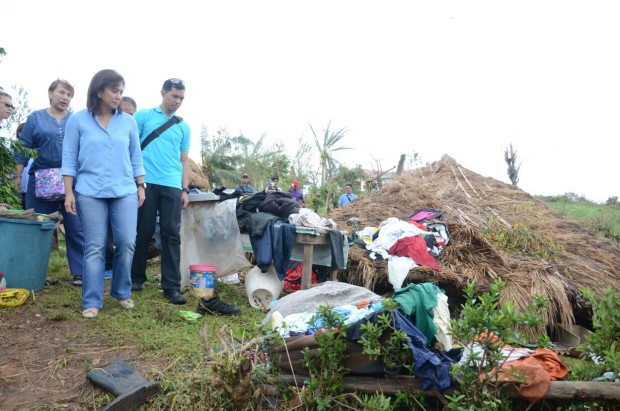Ivatans’ wrecked homes to rise stronger, Robredo tells residents
BASCO, Batanes—Building new houses in this northernmost province that could withstand extremely strong winds and rain would be on top of the government’s housing agenda, Vice President Leni Robredo said in Itbayat town on Monday.
Robredo visited the island town, which suffered the most damage last week when Typhoon “Ferdie” (international name: Meranti) blew into the province, battering houses and destroying crops and infrastructure worth P450 million.
Robredo, who was briefed here by Gov. Marilou Cayco on the damage wrought by Ferdie, offered emergency housing assistance and said she would help rebuild the damaged houses “into shelters that are tougher because typhoons have become stronger now.”
Batanes has been the benchmark for storm preparedness.
“Long before climate change became the talk of the global village, the Ivatan, whose communities have long been regarded as the ‘home of typhoons,’ had learned to live with and adapt to a hostile climate,” the indigenous rights advocate Tebtebba Foundation said. “They erected stone houses made of limestone, designed to keep them safe and warm amid pounding rains and howling winds.”
Article continues after this advertisementLearn a thing or two
Article continues after this advertisement
Some of the older Ivatan houses survived Ferdie. Homes with modern roofs had it blown off but not homes with cogon roofs.
The rest of the country, especially the communities in coastal areas, can learn a thing or two from Itbayat communities on disaster preparedness, said Itbayat Mayor Raul de Sagon.
“We always see to it that our communities are far from the shoreline, with the nearest household living about 2 kilometers from the sea. This way, we are safe from flash floods and storm surges,” he said.
But after Ferdie’s onslaught, Itbayat residents are in dire need of basic supplies like water, rice and food, as they pick up the pieces of Ferdie’s devastation, De Sagon said.
De Sagon said the town did not suffer any casualties despite the widespread damage.
Immediate relief efforts in the town, he said, focused on restoring power and communication lines, as well as allowing the airlift of relief goods.
“We will also need construction materials to rebuild damaged houses, schools and churches. Our farmers also need to recover from destroyed crops,” De Sagon said. Itbayat farmers grow rice, corn and root crops.
According to the mayor, the typhoon’s impact on the island was aggravated by similar damage wrought on Batan Island and the capital town of Basco, where Itbayat folk get their basic commodities.
Cresencia Cordel, 58, a Basco resident, said the typhoon was the strongest she experienced in recent years. “I was so scared because I had eight grandchildren to worry about. So we evacuated to the Diptan Elementary School,” she said.
Airlifted relief
Meanwhile, the Department of Social Welfare and Development said its second airlifted relief mission to the province had reached Itbayat, delivering 20 sacks of rice, four boxes of water, 20 boxes of canned goods and food packs, and assorted medical supplies and drugs.
Itbayat officials initially estimated the damages at P64.7 million due to the destruction of a number of houses, electric posts, school buildings as well as crops and livestock.
Relief workers from the DSWD and other government agencies reached Batanes on Saturday on board a Philippine Air Force C-130 cargo plane.
